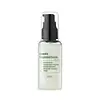What's inside
What's inside
 Key Ingredients
Key Ingredients

 Benefits
Benefits

 Concerns
Concerns

No concerns
 Ingredients Side-by-side
Ingredients Side-by-side

Water
Skin ConditioningSqualane
EmollientPolyglyceryl-6 Stearate
EmollientPropanediol
SolventIsoamyl Laurate
EmollientTocopherol
AntioxidantCetearyl Alcohol
EmollientEthoxydiglycol
HumectantPanthenol
Skin ConditioningEctoin
Skin ConditioningCorn Starch Modified
AbsorbentSilanetriol
Adenosine
Skin ConditioningBentonite
AbsorbentSodium Hyaluronate
HumectantGlucosyl Ceramide
Skin ConditioningPhospholipids
Skin ConditioningCholesterol
EmollientAllantoin
Skin ConditioningAsiaticoside
AntioxidantMadecassic Acid
Skin ConditioningAsiatic Acid
Skin ConditioningSodium Carboxymethyl Beta-Glucan
CleansingPolyglyceryl-6 Behenate
Emulsion StabilisingLactic Acid
BufferingSodium Phytate
Hydroxyethyl Acrylate/Sodium Acryloyldimethyl Taurate Copolymer
Emulsion StabilisingDehydroacetic Acid
PreservativeBenzyl Alcohol
PerfumingWater, Squalane, Polyglyceryl-6 Stearate, Propanediol, Isoamyl Laurate, Tocopherol, Cetearyl Alcohol, Ethoxydiglycol, Panthenol, Ectoin, Corn Starch Modified, Silanetriol, Adenosine, Bentonite, Sodium Hyaluronate, Glucosyl Ceramide, Phospholipids, Cholesterol, Allantoin, Asiaticoside, Madecassic Acid, Asiatic Acid, Sodium Carboxymethyl Beta-Glucan, Polyglyceryl-6 Behenate, Lactic Acid, Sodium Phytate, Hydroxyethyl Acrylate/Sodium Acryloyldimethyl Taurate Copolymer, Dehydroacetic Acid, Benzyl Alcohol
Centella Asiatica Extract 49%
CleansingWater
Skin ConditioningGlycerin
HumectantDipropylene Glycol
HumectantNiacinamide
SmoothingButylene Glycol
Humectant1,2-Hexanediol
Skin ConditioningGlycereth-26
HumectantCeramide NP
Skin ConditioningSodium Hyaluronate
HumectantAsiaticoside
AntioxidantAsiatic Acid
Skin ConditioningMadecassic Acid
Skin ConditioningPalmitoyl Hexapeptide-12
Skin ConditioningPalmitoyl Tripeptide-1
Skin ConditioningPalmitoyl Tetrapeptide-7
Skin ConditioningPalmitoyl Dipeptide-10
Skin ConditioningCarbomer
Emulsion StabilisingArginine
MaskingSclerotium Gum
Emulsion StabilisingHydrolyzed Jojoba Esters
Skin ConditioningCaprylyl Glycol
EmollientPolyglyceryl-10 Myristate
Skin ConditioningPanthenol
Skin ConditioningPolyglyceryl-10 Laurate
Skin ConditioningHydrogenated Lecithin
EmulsifyingCamellia Sinensis Leaf Extract
AntimicrobialPancratium Maritimum Extract
BleachingDipotassium Glycyrrhizate
HumectantDisodium EDTA
Adenosine
Skin ConditioningCentella Asiatica Extract 49%, Water, Glycerin, Dipropylene Glycol, Niacinamide, Butylene Glycol, 1,2-Hexanediol, Glycereth-26, Ceramide NP, Sodium Hyaluronate, Asiaticoside, Asiatic Acid, Madecassic Acid, Palmitoyl Hexapeptide-12, Palmitoyl Tripeptide-1, Palmitoyl Tetrapeptide-7, Palmitoyl Dipeptide-10, Carbomer, Arginine, Sclerotium Gum, Hydrolyzed Jojoba Esters, Caprylyl Glycol, Polyglyceryl-10 Myristate, Panthenol, Polyglyceryl-10 Laurate, Hydrogenated Lecithin, Camellia Sinensis Leaf Extract, Pancratium Maritimum Extract, Dipotassium Glycyrrhizate, Disodium EDTA, Adenosine
 Reviews
Reviews

Ingredients Explained
These ingredients are found in both products.
Ingredients higher up in an ingredient list are typically present in a larger amount.
Adenosine is in every living organism. It is one of four components in nucleic acids that helps store our DNA.
Adenosine has many benefits when used. These benefits include hydrating the skin, smoothing skin, and reducing wrinkles. Once applied, adenosine increases collagen production. It also helps with improving firmness and tissue repair.
Studies have found adenosine may also help with wound healing.
In skincare products, Adenosine is usually derived from yeast.
Learn more about AdenosineAsiatic Acid is a major component of Centella Asiatica Extract. It has wound-healing, anti-inflammatory, and antioxidant properties.
Studies show Asiatic Acid is able to block the pathway for skin inflammation receptors, helping to soothe skin.
As an antioxidant, asiatic acid helps protect our skin against damaging environmental factors.
Learn more about Asiatic AcidAsiaticoside comes from the super popular skin-soothing ingredient, Centella asiatica. It is one of four active compounds found in the extract of Centella Asiatica.
Asiaticoside is an antioxidant and helps with wound healing. It has been shown to increase antioxidant activity during the wound healing process.
Madecassic Acid is a major component of Centella Asiatica Extract. It has anti-inflammatory and antioxidant properties.
It is a triterpenoid, meaning it naturally acts as an antioxidant. Antioxidants protect your skin against damage from environmental factors such as pollution and UV.
Studies show Madecassic Acid helps soothe the skin due to its ability to block inflammation pathways.
Learn more about Madecassic AcidPanthenol is a common ingredient that helps hydrate and soothe the skin. It is found naturally in our skin and hair.
There are two forms of panthenol: D and L.
D-panthenol is also known as dexpanthenol. Most cosmetics use dexpanthenol or a mixture of D and L-panthenol.
Panthenol is famous due to its ability to go deeper into the skin's layers. Using this ingredient has numerous pros (and no cons):
Like hyaluronic acid, panthenol is a humectant. Humectants are able to bind and hold large amounts of water to keep skin hydrated.
This ingredient works well for wound healing. It works by increasing tissue in the wound and helps close open wounds.
Once oxidized, panthenol converts to pantothenic acid. Panthothenic acid is found in all living cells.
This ingredient is also referred to as pro-vitamin B5.
Learn more about PanthenolSodium Hyaluronate is hyaluronic acid's salt form. It is commonly derived from the sodium salt of hyaluronic acid.
Like hyaluronic acid, it is great at holding water and acts as a humectant. This makes it a great skin hydrating ingredient.
Sodium Hyaluronate is naturally occurring in our bodies and is mostly found in eye fluid and joints.
These are some other common types of Hyaluronic Acid:
Learn more about Sodium HyaluronateWater. It's the most common cosmetic ingredient of all. You'll usually see it at the top of ingredient lists, meaning that it makes up the largest part of the product.
So why is it so popular? Water most often acts as a solvent - this means that it helps dissolve other ingredients into the formulation.
You'll also recognize water as that liquid we all need to stay alive. If you see this, drink a glass of water. Stay hydrated!
Learn more about Water